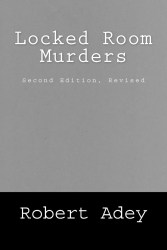My first experience of the French crime/suspense duo Pierre Boileau and Thomas Narcejac was the recent Pushkin Press reissue of She Who Was No More (1952, tr. 2015) and…well, I didn’t love it. But Adey lists this novella and so back on the horse we clamber.
It’s…an odd one. Without that earlier experience of their hallucinogenic, tumbling prose style I think I’d like this a lot less — and maybe had I read this first I’d like that one a lot more — but there can be no denying that inside the nightmarescape of confusion and melodrama Boileau-Narcejac have crafted something brilliantly French and (one feels) deliberately difficult to pigeonhole. Gleeps, how in the hell am I going to write anything about this one…?
The edition I read was the Hutchinson translation from 1959, which pairs this novella with a much longer novella entitled ‘The Evil Eye’/’Le Mauvais Oeil’ (1956) which John Norris has written about most enthusiastically here, motivating Martin Edwards to follow up with equally fulsome praise. I didn’t get to that one, partly because of its length — I pretty much had one day in the British Library to read and write notes on all the stories featuring this month — and partly because I think I can do only so much Boileau-Narcejac at any given time. It’s not that I don’t find them enjoyable, but I don’t find them enjoyable in the way I enjoy, say, Freeman Wills Crofts (and I can only do so much Crofts in a day) or John Dickson Carr. I can feel the tendrils of Boileau-Narcejac gradually entwining around me and pulling me in, but I’m not fully indoctrinated into their school of Gallic alacrity just yet. I need some jokes to break it up, y’know? Or a clever deduction or something.
Yeah, I’m a philistine. And I don’t even spell that with a capital P. Clearly there’s no hope for me.

Hello, darkness, my old friend…
‘The Sleeping Beauty’/’Au Bois Dormant’ (1956) is the tale of Pierre-Aurelién de Muzillac du Quilly, who with a name like that can only be some French nobility cast into exile and keen to exact his revenge. Sure enough, following the death of his mother, he heads back to his homestead to reclaim that which has been snatched away, and it’s pretty clear from the outset what manner of ride we’re in for:
I was near to fainting with joy and fear, with bitterness and hope. I wanted to cry aloud with anger, and I cast myself down on the bed, overwhelmed by the violence of my sentiments.
Baron Herbeau, head of the family now occupying Pierre-Aurelién’s family pile — “They have bought it (for a song, let me tell you in confidence)” — is unaware of the return of Monsieur le comte, and any attempt to get to know the man and his intentions are foiled by the fact that the locals obviously have long memories and “[n]o-one who belongs here would acknowledge them if they were to show themselves in public”. However, it transpire that “[t]he Baron has been living for years in terror of this day. You have only to show yourself and he’ll be off”.
Pierre-Aurelién is not purely out for revenge, however, he’ll settle for a simple reacquisition of what is rightfully his, and so offers to buy the man out of the castle seen as his birthright, reasoning that Baron Herbeau will have a family to support. And then it just so happens that this family includes a daughter, the comely 20 year-old Claire, with whom Pierre-Aurelién is rather taken at first sight:
[A]lready I was in love with a young girl whom I had hardly seen as she stood in the gathering twilight at the edge of the great terrace; and I was filled with hatred for such a love. For a long time I stood leaning at my window, watching the moon mount slowly into the heavens, listening to the dogs barking to one another across the still acres of the country air.
We’re 20 pages into a 60-page story at this point, and it’s more Mills & Boon than Locked Room. It’s all very courtly, with a lot of heaving bosoms implied, and far too much being excited at seeing someone through a window or riding their horse in some woodland. And then things start getting weird…


Not read this one but yes, their stories are all about the final effect it seems with often remarkably little sympathy for their characters, who are often very easy to dislike.
LikeLike
They don’t seem big on sympathy, no, even on this small sample. Both this and SWWNM trade heavily on a sort of heady, semi-delirious atmosphere wherein the protagonist is quick to jump at shadows and scream his way to a thoroughly irrational course of action rather than, y’know, behaving intelligently and reasonably.
This definitely has the upper hand in how the various threads pull together, however, and there’s a piece of misdirection that’s as simple and gorgeous as anything I’ve encountered in the genre. In time, I hope to come to really appreciate what B-N do, because I can already see distinct sparkles in their work which I don’t believe any others would have even considered trying to accomplish.
LikeLiked by 2 people
Oh JJ, you keep picking the wrong books. If you wanted to read the best locked room mystery novel by this team you should have picked THE TUBE. B-N have written only a handful of detective novels or crime novels with detective novel elements. As you know they are not known for traditional detective novel writing at all. But THE TUBE should be the one that would most likely satisfy you rather than this macabre thriller.
I also think you would like THE PRISONER (pure suspense, not detection) and HEART TO HEART (modest bit of detection). They are the best of the English translated books I’ve read.
If I knew French I would seek out one about a magician and his twin daughters which from the two references I stumbled across in my B-N research sounds like a very trippy book. The basic plot premise was recently used in an American TV show (“Deception”) that lasted only a few episodes. Have no idea if the creators knew of the B-N book which used sisters rather than brothers. Could be. One never knows with all the imitating/ borrowing/”homage paying” going on in the entertainment world these days.
LikeLike
I haved toyed with the idea of reserving something absurdly rare at the BL and just going in to read through it in a day, which I’d have to do with The Tube (and, believe me, I’m tempted…). The problem is that I don’t have the reading speed of Aidan, Puzzle Doctor, or Kate, and so the chances of me finishing it between the allotted hours is…very slim. And then I’d have to wait a couple of weeks before going back, which would probably drive me to distraction.
I appreciate the direction you’re giving me, howvwer, John, on the off-chance these to get reprinted, become available for sale at an affordable price, or I get my speed-reading up to snuff. And that one about the magician does sound interesting; I shall investigate further…
LikeLike